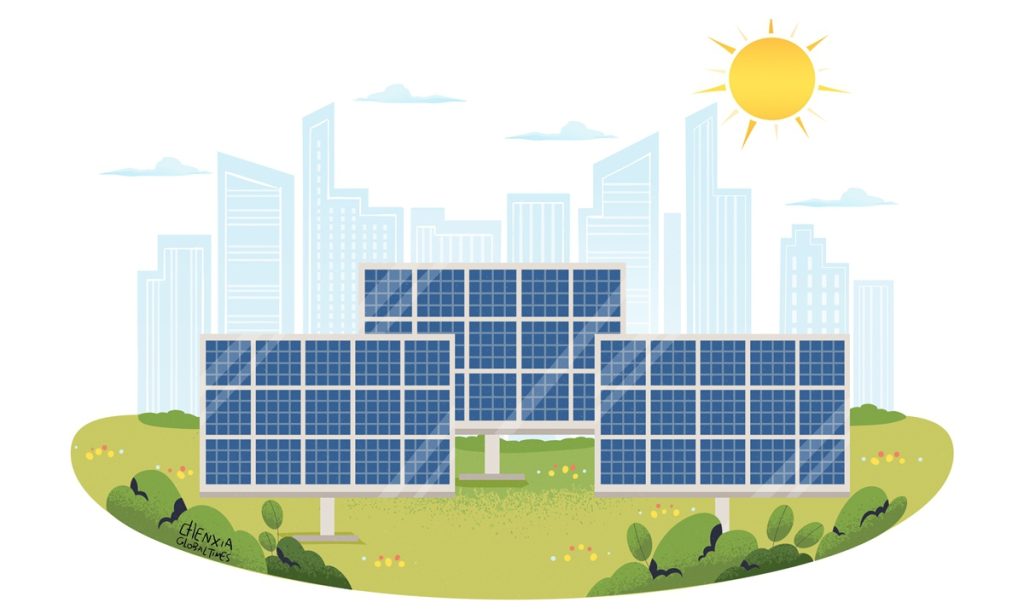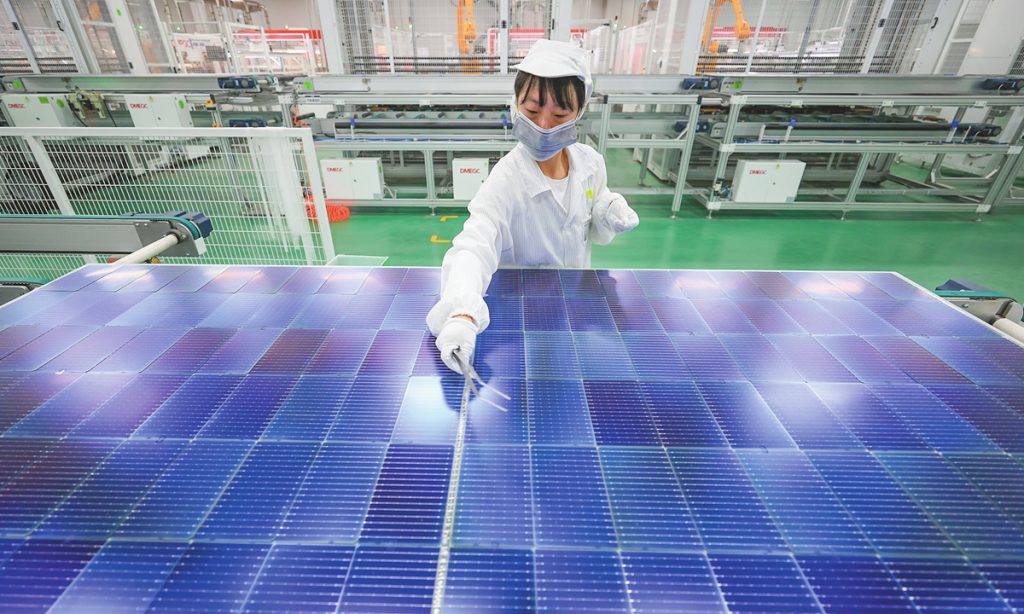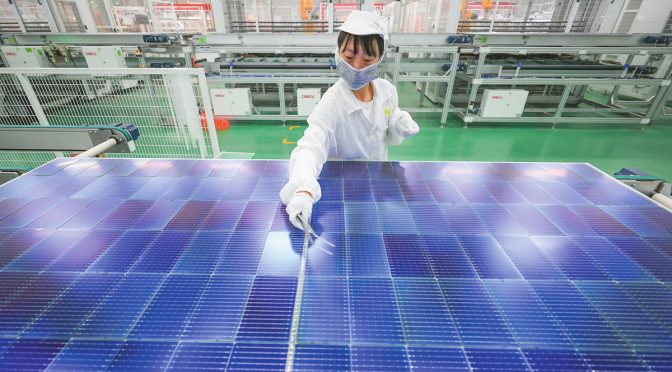Following the recent approval from the China Securities Regulatory Commission, the Guangzhou Futures Exchange launched polysilicon futures on Thursday, with polysilicon options scheduled to debut on Friday.
This landmark move not only marks a significant step for China in establishing a pricing mechanism for polysilicon but also indicates that China’s position in the global photovoltaic industry will be further strengthened.

Polysilicon is primarily used as a major raw material for the production of the photovoltaic industry. Its fluctuations in polysilicon prices not only directly affect the operation of photovoltaic companies but also have significant implications for the healthy and sustainable development of the entire industrial chain.
With the launch of the polysilicon futures, its price discovery mechanism will more accurately reflect the supply and demand dynamics of the domestic polysilicon industry, thereby establishing a “China price” for polysilicon trade. The formation of this price will gradually expand China’s influence in the pricing of international polysilicon trade, giving China a bigger voice and pricing power in the global polysilicon market.
Historically, the global polysilicon market has experienced significant growth and changes. At first, the production of polysilicon was monopolized by a few developed countries because of high technological barriers and high production costs. However, technological advancements and decreasing costs have facilitated the global spread of polysilicon production, resulting in a more diversified market landscape.
China, with its rich resources, comprehensive industrial chain, and strong manufacturing capabilities, has rapidly emerged as the world’s largest polysilicon producer. This has accelerated the development of China’s photovoltaic industry, also making a substantial contribution to the prosperity of the global photovoltaic market.
At present, China is the world’s largest producer and consumer of polysilicon. According to data from the Silicon Industry Branch of China Nonferrous Metal Industry Association, global polysilicon production increased from 300,000 tons in 2014 to 1.597 million tons in 2023. China’s production accounted for 92.08 percent of the global polysilicon supply in 2023, representing an absolute dominant position.
However, despite China’s remarkable growth in polysilicon production, it remains in a passive position regarding international trade pricing. Due to the lack of an effective futures market as a price discovery tool, Chinese polysilicon companies often have no choice but to passively accept fluctuations in international market prices, which increases the operational risks for these companies and limits China’s influence in global polysilicon trade.
In recent years, polysilicon prices have exhibited significant volatility, with annual price fluctuation rates reaching 226.63 percent, 63.49 percent, and 280.17 percent from 2021 to 2023, according to the Economic Daily.
As a result, managing price volatility risks of its core upstream raw materials has become essential for the long-term healthy development of the photovoltaic industry.
Given that China is the world’s leading producer of polysilicon, it deserves greater pricing power in the global market to match its dominant position in the industry. Without influence over pricing, Chinese companies may suffer from unfair pricing in international trade, making it difficult to effectively safeguard their own interests.
Moreover, since the significant fluctuations in polysilicon prices directly affect the production efficiency of photovoltaic companies and the overall stability of the entire industrial chain, the introduction of polysilicon futures offers companies effective risk management tools. It enables various segments of the industry to lock in production costs and anticipated profits in advance, thereby ensuring stable operations. Additionally, these futures provide the market with reasonable forward price guidance, helping to mitigate the risk of overcapacity in the polysilicon sector. This promotes balanced and coordinated development across both the upstream and downstream segments of the industrial chain, enhancing the core competitiveness of China’s photovoltaic industry.
In addition, with many photovoltaic companies eyeing overseas investment as their global strategy, polysilicon futures could also play a crucial role in supporting this expansion. Over time, these futures prices may evolve into an international price benchmark, further enhancing China’s influence in the pricing of global polysilicon trade. In the meantime, this development will offer a transparent and equitable price reference for the global photovoltaic industry, promoting healthy growth of the market and injecting stability and certainty into the global photovoltaic sector.

A worker rushes to fulfill orders on the production line at a photovoltaic company in Lianyungang, East China’s Jiangsu Province on December 25, 2024. From January to October, production of polysilicon, silicon wafers, cells, and modules for photovoltaics increased by more than 20 percent year-on-year, and the export volume of photovoltaic cells rose by more than 40 percent, official data showed. Photo: VCG
China Energy Storage Alliance (CNESA) organized a closed-door seminar in Beijing on Thursday to address involution-style competition in the new energy storage sector, with participation from nearly 30 industry-leading companies, an employee with the alliance confirmed to the Global Times on Thursday without further elaboration.
A document obtained by Jiemian News indicates that the meeting covers three main discussion topics, one of which addresses “anti-involution competition and anti-below-cost price competition,” and measures to prevent bidding below cost.
The event also focused on discussions on measures to curb “involution,” including increasing entry thresholds, standardizing technical conditions, improving the standards system, enhancing safety protection levels, and restraining local capital from impulsive investing.
At the meeting, industry participants also discussed promoting high-quality development in new energy storage and the direction of key technological advancements.
The call to reject involution is a positive one, as it seeks to promote healthy and sustainable industry growth, Lin Boqiang, director of the China Center for Energy Economics Research at Xiamen University, told the Global Times on Thursday. .
The central authorities have also urged governments of various levels to take necessary measures to prompt industries to strengthen self-discipline and prevent vicious “involutionary” competition.
During the annual Central Economic Work Conference held in Beijing from December 11 to 12, it urged “addressing rat-race irrational competition and regulating behaviors of local governments and enterprises,” Xinhua reported.
This followed a meeting held on July 30 of this year by the Political Bureau of the Communist Party of China Central Committee, which pointed out that “it is a must to reinforce industry self-discipline to prevent vicious ‘involution’ competition. Market competition mechanism must be strengthened to ensure smooth channels for the exit of outdated and inefficient production capacities,” as Xinhua reported.
On Tuesday, two domestic large silicon material companies Tongwei Co and Xinjiang Daqo New Energy Co announced via their official WeChat accounts that, to curb ‘involution’ and prevent ‘vicious’ competition, the two silicon material companies will implement orderly production cuts and control production.
Noticeably, Yongxiang Co, a subsidiary of Tongwei, has a high-purity crystalline silicon production capacity of over 900,000 tons and has maintained the highest market share globally for several consecutive years, domestic news portal ce.cn reported, noting that the production cuts initiated by leading companies will have a significantly positive impact on the industry.
Commenting on the moves by industry players, Lin said that “combating industry ‘involution’ aligns with high-quality development… and if industry professionals can better self-regulate, it will be a win-win situation for long-term.”
On December 5, at the 2024 Annual Conference of the PV Industry, the China Photovoltaic Industry Association organized 33 leading industry companies to sign an industry “self-discipline agreement,” Xinhua reported. This agreement calls for PV companies to voluntarily limit production and prices, the report said.
Additionally, the association vowed to deploy a professional team for on-site verification of production capacity at over 300 photovoltaic bases nationwide, said the report.
Global Times, Yin Yeping

